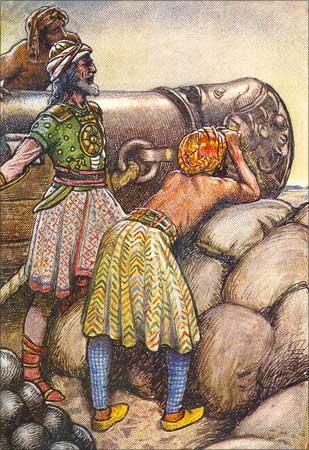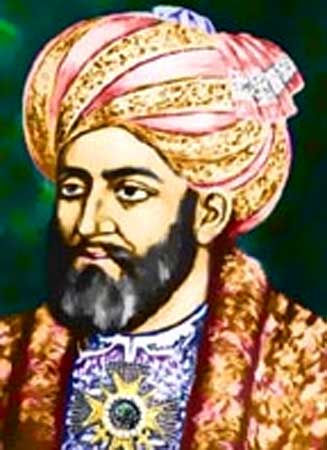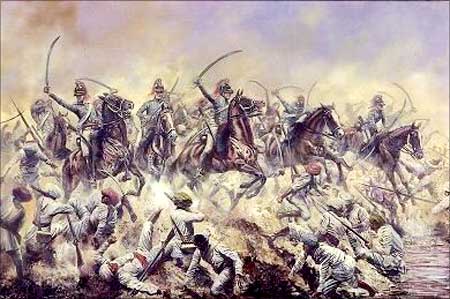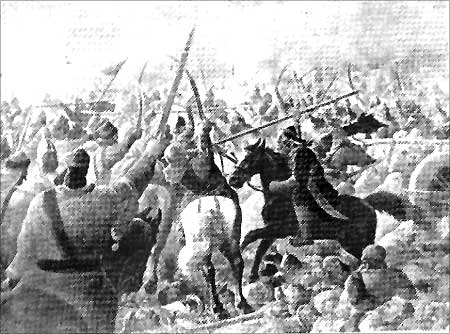
Throughout history, wars have left an indelible mark on human psyche. Serious debates have been held on the morality of and the strategic necessity for war.
And yet, like every dark cloud that has a silver lining, wars too at times leave a society wiser.
India too is no stranger to wars. And there are many lessons to be learnt from each of those battles -- management lessons, to be precise.
This one picks out management gems from the Third Battle of Panipat (1761 AD).
Text: Utkarsh Rai
The author, based in Bangalore, is the managing director of an IT multinational firm. He has also written two books: Offshoring Secrets, and the forthcoming Myths & Realities @ the Office.
Disclaimer: Since history is replete with different versions of the same event, chances are that some of the stories written here might not match with the version that the reader is conversant with. However, the article has been written not with the intention of being unerringly accurate on the historic account, but to use the event as a source of information from which to draw strategic management lessons.
After the death of Aurangzeb, the Mughal empire was on the decline. The Marathas had captured most of the territories in the south. Slowly, they captured most of central and north India too.
They occupied Delhi and captured Lahore by defeating the son of Ahmad Shah Abdali, the Afghan ruler.
Abdali built his army and left Afghanistan to stop the expansion of the Maratha empire. He sought an alliance with Najib Khan, the chief of the Rohilla soldiers. Even the Nawab of Awadh had extended his support.
The confident Marathas were led by Sadashivrao Bhau. They had a large army, but very few allies.
Most of the kings from the Jat, Sikh and Rajput kingdoms did not support the Marathas as they resented the heavy tax imposed on them during the Maratha capture of north India. A few of them even struck favourable agreements with Abdali.
Lesson: One needs allies; the need is even stronger when one is operating in a new territory/segment.
Whether the company is doing an acquisition or is entering into a partnership, the agreement should try to be a 'win-win' one where the minority stakeholder should feel respected and heard.
This will help the partnership flourish. Similarly, if a manager takes care of his team, his team rally for him in his hour of need.

The Marathas attacked the Afghan garrison on the banks of the river Yamuna at Kunjpura, north of Delhi, and killed or enslaved them.
The Yamuna was in spate and Abdali, who was on the other side, could not do anything to save them. Along with his soldiers, he took a risk, reached the south of Delhi and crossed the Yamuna there, where it was relatively easier.
He wanted to encircle Marathas. The Marathas were unaware of this as they were preoccupied with the skirmish at Kunjpura.
Lesson: One should learn from a setback and improve; one must have the determination to win. Sometimes, a better plan emerges that could increase the probability of success as in Abidali's case, where he saw his troops decimated on the other side of the river.
Similarly, one may need to take snap decisions depending on the situation.
An individual with a good network and a company that has good market intelligence can get the latest information, which could be crucial in planning and providing competitive advantage.
When the stakes are high, lack of intelligence can invariably prove fatal, as in the case of how Abdali crossing the Yamuna went unnoticed by the Marathas.

When the Marathas realised that the south of the Yamuna was captured by Abdali, they dug their heels in near Panipat to deny him access to Afghanistan.
Slowly, Abdali encircled the Maratha army and cut off their supply line.
The Afghans continued to get the supplies they needed due to their agreements with a few north Indian kingdoms. Therefore, their need to open up the route towards Afghanistan was not that urgent.
But it was a desperate situation for the Maratha army who were expecting reinforcements from the south of the Narmada instead of the neighbouring states.
Lesson: It is important to do 'what if' contingency analysis planning for various scenarios. This upfront analysis may trigger a new partnership or alignment which could benefit the company.
Sometimes, one has to provide new concessions to gain the required support and solidify one's position. Both wars and businesses can benefit from a deep multi-step scenario analysis.

There were tensions in the Maratha army due to Abidali's strategy.
In the next two months, the skirmishes between the two left many, including Najib Khan's soliders, dead.
Abdali sensed a deadlock and decided to sign a peace treaty with the Marathas.
The Marathas were keen as well, but Najib Khan advised against the treaty and prevailed upon Abdali to delay his decision.
Lesson: Empower and trust your team members.
One should have complementary skills among the senior management so that the leader can tap into a breadth of expertise.
Finally, decisions are taken by the leader but an environment that encourages different voices and dissenting opinions is more effective than the 'do as I tell you to do' attitude. This is what encouraged Najib to convince Abdali.
Even though Najib failed miserably in the initial phase, Abdali continued to give him a chance to prove himself.
Similarly, a manager needs to have faith in his team despite early setbacks, provided they possess the right skills; after all, every mistake is a learning experience.

The Marathas and the Afghans prepared their armies for a major battle, but waited as the Afghans didn't want to attack first and the Marathas were waiting for reinforcements to arrive.
Eventually, the deteriorating situation forced the Marathas to attack the Afghans before their reinforcements arrived. The Marathas had better French guns and made significant progress. Ibrahim Gardi played a key role in getting early breakthroughs for the Marathas.
By noon, it appeared that the Marathas would win.
Faced with imminent defeat, Abdali called on his highly trained reserve soldiers and cannon-mounted camels. From these camels, they could fire artillery which would go over their own infantry and started decimating the Maratha army.
The Maratha artillery, initially used to weaken the enemy defence, was now placed behind the infantry and thus became ineffective. Besides, Bhau did not have any significant reserves that could join them with artillery for a counter-attack.
Eventually, the tired Maratha forces could not match Abdali's reserve army. This turned the tide in Abdali's favour. By the end of the day, the Marathas had lost the battle.
Lesson: One should not give up the fight till the last moment.
The leader's behaviour during critical times can either motivate to overcome the challenge or lead to a psychological defeat where victory was possible.
It is also important to have a backup plan that can be used if the original one is not working, as Abdali did with the reserve troops and cannons on camels.
The leader should be bold in making changes in the team to ensure that a fresh mind can look into the issue from a new perspective and provide a solution, instead of the same tired mind being stuck in the same track of thought.

Both sides suffered huge losses. Soon after the battle, Abdali's alliance was consumed by infighting, forcing him to return to Afghanistan after anointing Shah Alam II as the Delhi emperor.
The third battle of Panipat ended the great Marathas' advance towards north-west India. However, after a few years under Peshwa Madhav Rao, they recaptured Delhi and retained it till 1818.
Lesson: To rise after a fall requires grit and determination.
It is not sufficient just to learn from mistakes and take corrective action. Changing the mindset of the team from being a loser to having faith in itself is a must. Then the team will rise and face the challenge again with confidence.
Projects that are failing or not doing well can be turned around by adopting this strategy.
The author, based in Bangalore, is the managing director of an IT multinational firm. He has also written two books: Offshoring Secrets, and the forthcoming Myths & Realities @ the Office.
Disclaimer: Since history is replete with different versions of the same event, chances are that some of the stories written here might not match with the version that the reader is conversant with. However, the article has been written not with the intention of being unerringly accurate on the historic account, but to use the event as a source of information from which to draw strategic management lessons.